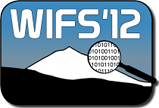This is the tutorials list, scheduled during the first day of WIFS (December 2nd):
- A primer on content protection systems
Speakers: G. Doërr, D. Alain, and T. Kalker.
December 2nd, 9:15 - 12:30
- Contents
- 1. Legal aspects of copyright protection
- a. Refresher on copyright law basics
- b. The notion of fair use; Betamax vs. P2P
- c. WIPO 1996 followed by DMCA, EUCD, Hadopi, etc
- d. SOPA
- e. Creative commons: an alternative?
- 2. The content protection toolbox and associated tools
- a. Cryptography (ciphers, hash functions, signatures, key distribution)
- b. Physical protection
- c. Jamming (Macrovision, anti-camcording, etc)
- d. Content watermarking
- e. Content fingerprinting
- 3. Content Protection Systems (CPS)
- a. Conditional Access Systems (CAS)
- b. Digital Rights Management (DRM)
- 4. The long march to interoperability
- a. A link protection to inter-connect CE devices (Cl+, HDCP)
- a.i. DTCP-IP: a case study
- b. The apparition of the domain
- b.i. A cartel of standards
- b.ii. Intermediation using a Rights Locker
- b.ii.1. Coral and Ultraviolet
- Cloud computing for network forensics
Speakers: J. François.
December 2nd, 9:15 - 12:30
- Contents
- 1. Introduction
- a. Is there a definition of cloud computing?
- b. The recent paradigm shift
- 2. MapReduce basis
- a. Logic programming
- b. Mappers
- c. Multiple reducers
- d. “Formal” definition
- 3. Hadoop
- a. A black box for MapReduce: what has to be implemented?
- b. The distributed file system: HDFS
- c. The components:
- c.i. For accessing and managing HDFS
- c.ii. For performing distributed tasks
- d. What about reliability and security?
- e. Installation/deployment issues
- 4. Complex job in MapReduce and performance issue
- a. Joining data
- b. Multiple jobs with complex dependencies
- c. Sorting data
- d. Binary data
- 5. Advanced network forensics related tasks in MapReduce/Hadoop
- a. IP flow analysis
- b. Botnet evidence tracking with Hadoop based data mining techniques
- c. Passive DNS analysis
- d. Combining multiple sources
- 6. Database-like in MapReduce
- 7. Hadoop extensions
- 8. Alternatives
- Biometric privacy and secrecy from information-theoretical perspective
Speakers: T. Ignatenko.
December 2nd, 14:00 - 17:15
- Contents
- 1. Introduction to biometric systems: goals, types of systems, performance measures
- 2. Security problems in access control systems
- a. Extra privacy problems in biometric access control systems
- 3. Useful (information theory) concepts and results
- a. i.i.d. random variables
- b. Entropy and mutual information
- c. Asymptotic Equipartition Property
- d. Noisy channel theorem
- e. Slepian-Wolf Coding
- f. Mrs. Gerber’s lemma
- 4. Biometric authentication systems
- a. Secret sharing and biometric systems
- b. Basic models for generated and chosen secrets
- c. Models with privacy leakage
- d. Models with zero-leakage
- e. Examples
- f. Guidelines for practical implementation
- g. Connection to FAR/FRR
- 5. Biometric identification systems
- a. Effect of multiple users
- b. Basic models
- c. Connection to other biometric systems
- 6. Understanding performance of practical construction
- a. Fuzzy commitment scheme
- b. Properties of fuzzy commitment
- Uncovering the processing history of video content
Speakers: A. Piva and S. Milani.
December 2nd, 14:00 - 17:15
- Contents
- 1. Video acquisition
- a. Strategies to identify the capturing device
- 2. Video coding
- a. Coding standard
- b. Coding parameters
- c. Number of multiple compression steps
- 3. Video doctoring
- a. Acquisition and coding inconsistency-based forensics analysis
- b. Traces left by the forgery
- 4. Video forensics open issues
- 5. Practical applications
- a. Tampering detection algorithms
- b. Video data validation
- c. Quality assessment
